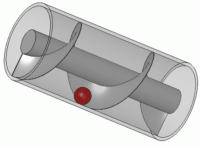The Archimedes’ screw, also known as the water screw, screw pump, Archimedean screw, or Egyptian screw, is a machine used to pull water from a low-lying water body.
Water is pumped by turning a screw-shaped surface inside a pipe. Archimedes screws are also used for materials such as powders and grains.

Further, Archimedes screws could produce power if they are driven by flowing fluid instead of lifting fluid. These are known as Archimedes screw turbines or generators.

Although commonly attributed to Greek mathematician Archimedes, there is some evidence that the device had been used in Ancient Egypt long before his time.
Principle
The Archimedes screw is a form of positive-displacement pump. A positive-displacement pump traps fluid from a source and then forces the fluid to move to a discharge location.
Archimedes screw pumps consist of
1. Screw (a helical surface surrounding a central cylindrical shaft)
2. A hollow pipe inside which the screw is placed.
3. A geared motor to turn the screw in this case.
As the shaft turns, the bottom end pull up a volume of water or other liquid. This water will slide up inside the spiral tube until it finally pours out from the top of the tube.
The screw is usually used to move large volumes of water over short distances and heads.

The contact surface between the screw and the pipe does not need to be perfectly watertight. However, the better the contact consistency, the better the efficiency.
Most modern designs are very accurate and take a short period to fit together accurately and achieve maximum efficiency.
In some designs, the screw is fixed to the casing. They rotate together instead of the screw turning within a stationary casing. In the larger structures, the trough tends to be fixed, and the screw moves within it.
Practical Applications
The main application of the screw throughout history was to transport water to irrigation systems and for dewatering mines or other low-lying areas.

Archimedes screws are used in sewage treatment plants because they cope well with varying flow rates and suspended solids. An auger in a snow blower or grain elevator is essentially an Archimedes screw. Many forms of axial flow pump contain an Archimedes screw.
The principle is also found in escalators – Archimedes screws designed to lift fish safely from ponds and transport them to another location. This technology is used primarily at fish hatcheries, where it is desirable to minimize fish’s physical handling.
An Archimedes screw was used in the successful 2001 stabilization of the Leaning Tower of Pisa. Small amounts of subsoil saturated by groundwater were removed from far below the north side of the tower, and the weight of the building itself corrected the lean.

Archimedes screws are also used in chocolate fountains.
Archimedes Screws Turbines (ASTs) are a new form of generators for small hydroelectric powerplants that could be applied even in low head sites. The low rotation speed of ASTs reduces negative impacts on aquatic life and fish.
FAQ
Archimedes Screw is a machine used to pull water from a low-lying water body.
The archimedean screw is used for
1. Lifting Water
2. Sewage Treatment
3. It was used in stabilization of the Leaning Tower of Pisa
As the screw inside the hollow cylinder rotates, it scoops up the water from low lying area and pulls it to the top.

